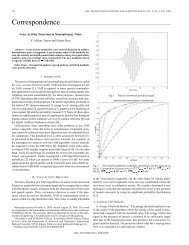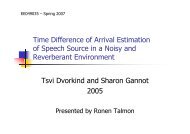Thesis (PDF) - Signal & Image Processing Lab
Thesis (PDF) - Signal & Image Processing Lab
Thesis (PDF) - Signal & Image Processing Lab
Create successful ePaper yourself
Turn your PDF publications into a flip-book with our unique Google optimized e-Paper software.
18 CHAPTER 2. THEORETICAL BACKGROUND<br />
end up with a non natural description of the inclusion. Naturally, in the example of<br />
Fig. 2.3(a), one would have expected to have the two small squares included into the<br />
gray rectangle, and included into the white background. But the inclusion for these<br />
trees is mostly driven by the gray level rather than by the geometrical inclusion.<br />
Finally, we see that we need both trees if we want to have the two small squares<br />
represented, since each of them appears in one description, and not in the other.<br />
Now, instead of upper and lower sets, lets us introduce a term of shape. A shape<br />
is a connected component of upper or lower set without any holes in it. If a hole<br />
exists, it is filled. The shape corresponds to the connected component and its filled<br />
”holes”.<br />
The sorting of shapes can then be made thanks to their geometrical inclusions.<br />
We can then create a tree structure as follows: each node corresponds to a shape;<br />
descendants are the shapes included into it, and the parent is the smallest shape that<br />
contains it (see Fig. 2.3(b) ). Each shape can specify either a gray level difference<br />
between it and its father or an absolute gray level.<br />
This will give us one single inclusion tree describing the image, in which a white<br />
object on black background is represented in the same manner as a black object on<br />
a white background.<br />
2.3 Theoretical Background on semilattices<br />
Mathematical Morphology is a nonlinear image processing theory, which was based<br />
on complete lattices. In [21] Keshet has extended its scope to complete semilattices,<br />
which are more general. This section provides a brief overview of Mathematical<br />
Morphology on complete semilattices.<br />
2.3.1 Complete Semilattices and Lattices<br />
A partially ordered set A is a set associated with a binary operator ≤, satisfying the<br />
following properties for any x, y, z ∈ A: reflexivity (x ≤ x), anti-symmetry (x ≤<br />
y, y ≤ x ⇒ x = y), and transitivity (x ≤ y, y ≤ z ⇒ x ≤ z). In a partially ordered<br />
set A, the least majorant ∨X (also called supremum) of a subset X ⊆ A is defined<br />
as an element a0 ∈ A, such that:
















